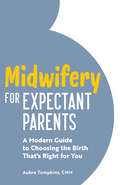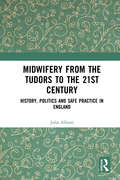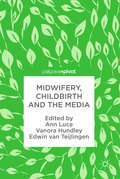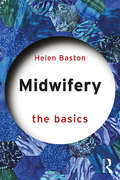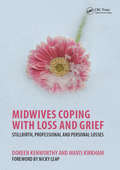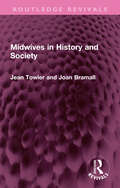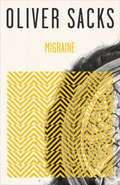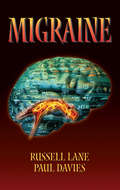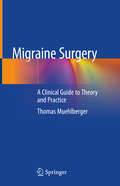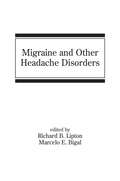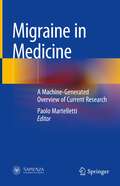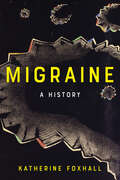- Table View
- List View
Midwifery at a Glance (At a Glance (Nursing and Healthcare))
by Eleanor ForrestMidwifery at a Glance offers an easy-to-read yet comprehensive overview of everything a midwifery student needs to know, from conception to care of the newborn. This practical guide provides coverage of normal pregnancy, maternal and foetal physiology, and pre-existing medical conditions and how these affect pregnancy and birth. It also features vital information on the role of the midwife, evidence-based practice, health promotion education, and perinatal mental health, as well as neonatal care and an overview of emergency situations. Midwifery at a Glance: Contains superb full colour illustrations throughout Is written specifically for midwifery students and includes all the concepts found on the midwifery curriculum Demonstrates links with other relevant multidisciplinary healthcare professionals Midwifery at a Glance is the ideal guide, offering educational support for midwifery students in the application of midwifery knowledge into clinical practice.
Midwifery for Expectant Parents: A Modern Guide to Choosing the Birth That's Right for You
by Aubre TompkinsA 21st-century guide to midwifery—tons of up-to-date information for expectant parents Whether you're in your third trimester or trying to conceive, knowledge is power when it comes to making important decisions about what kind of care you'll receive during pregnancy and childbirth. Midwifery for Expectant Parents is your resource for information about modern midwifery, letting you navigate your pregnancy journey with confidence and strength. It's never too early or too late to educate yourself and know your choices. Discover how midwifery blends evidence-based medical treatment with a respectful, supportive approach that puts you and your needs first from preconception to postpartum. Midwifery for Expectant Parents includes: All about midwifery—Get an extensive introduction to midwifery, including its benefits, history, philosophy, methodology, and more. Support for every stage—Explore helpful information that walks you through every stage of the pregnancy, birth, and postpartum process and explains how a midwife will support you each step of the way. Real birth stories—Read about others' experiences with midwifery, from pregnancy to labor, birth, and postpartum. Take a deep dive into modern midwifery with all the helpful guidance and up-to-date information you'll need to feel empowered before, during, and after your pregnancy.
Midwifery from Tudors to the 21st Century: History, Politics and Safe Practice in England
by Julia AllisonThis book recounts the journey of English midwives over six centuries and their battle for survival as a discrete profession, caring safely for childbearing women. With a particular focus on sixteenth and twentieth century midwifery practice, it includes new research which provides evidence of the identity, social status, lives, families and practice of contemporary midwives, and argues that the excellent care given by ecclesiastically licensed midwives in Tudor England was not bettered until the twentieth century. Relying on a wide variety of archived and personally collected material, this history illuminates the lives, words, professional experiences and outcomes of midwives. It explores the place of women in society, the development of midwifery education and regulation, the seventeenth century arrival of the accoucheurs and the continuing drive by obstetricians to medicalise birth. A fascinating and compelling read, it highlights the politics and challenges that have shaped midwifery practice today and encourages readers to be confident in midwifery-led care and giving women choices in childbirth. It is an important read for all those interested in childbirth.
Midwifery in China (Routledge Contemporary China Series)
by Rosemary Mander Ngai Fen CheungThe first book to present the history, ideas, life and works of Chinese midwives and birth attendants, this volume seeks to encapsulate and explain the changing ideas about the practice of midwifery in China. Using participant observations and interviews, it examines each phase of the development of midwifery in depth. Providing a systematic study of the existing literature and contemporary national health policies, it analyses the factors contributing to the current demise of midwifery in China, such as the absence of national regulation, high standards of education and national midwives’ associations. Furthermore, it argues that China’s national statistics in the past six decades demonstrate clear evidence that minimising maternal mortality rates will only happen through wider availability of services, rather than through obstetric technology or facility based care. Ultimately, therefore this book supports the view that humanity and midwifery will survive to overcome domination by both technology and market forces and that economic growth and medical technology alone will not be sufficient in providing effective healthcare. This book is an indispensable resource for the study of Chinese midwifery, both in theory and in practice. As such it will be useful to students and scholars of Midwifery, Women’s Health, Sociology and culture and society in China.
Midwifery, Childbirth and the Media
by Ann Luce Vanora Hundley Edwin Van TeijlingenThis edited collection - one of a kind in its field - addresses the theoretical and practical implications facing representations of midwifery and media. Bringing together international scholars and practitioners, this succinct volume offers a cross-disciplinary discussion regarding the role of media in childbirth, midwifery and pregnancy representation. One chapter critiques the provision and dissemination of health information and promotional materials in a suburban antenatal clinic, while others are devoted to specific forms of media - television, the press, social media - looking at how each contribute to women's perceptions and anxieties with regard to childbirth.
Midwifery: The Basics (The Basics)
by Helen BastonMidwifery: The Basics provides an engaging and authentic insight into the midwife’s world. It explores the role of the midwife as a clinician and professional, showing how midwives can support women both to achieve a healthy full-term pregnancy and a smooth transition to motherhood. This book begins with a discussion of the context of birth and parenthood, placing midwifery in its broader social context. Topics covered include: the midwife as an autonomous professional; becoming a midwife; pre-conceptual and antenatal care; intrapartum care; postnatal care; and the specialist midwife. Midwifery: The Basics uses the voices of mothers, fathers and midwives to illustrate the complex world of becoming, being and supporting parents. This is an essential introduction for students at undergraduate and A-Level who are approaching midwifery for the first time.
Midwives Coping with Loss and Grief: Stillbirth, Professional and Personal Losses
by Doreen Kenworthy Mavis KirkhamThe experience of stillbirth and other losses in pregnancy at what is usually a time of great joy is tragic for everyone involved, including midwifery professionals. Although research increasingly shows how profound the effects of loss can be, few studies have explored the effects of pregnancy loss - which often leads to other personal and professional traumas such as loss of autonomy or a workplace - on midwives. This in-depth investigation uses a phenomenological approach to capture midwives' experiences of loss and grief in their own words, and encompasses both pregnancy loss and wider professional and personal issues. It then makes recommendations to enhance midwives' resilience and ability to cope appropriately, whilst giving maximum support to their clients. Reflections on the emerging implications for midwifery education and practice further broaden the scope of the analysis. The insights in this book will be of great use to midwifery managers and supervisors. They will also help midwives to nurture themselves, their colleagues and their clients at a time when pressures on the service can leave support lacking. The devastating experience of losing a baby for women and their families is something that, as midwives, we strive to understand in order to provide appropriate practical and emotional support. Doreen and Mavis encourage us to consider how we are affected by the grief of others at a deeply personal level. Ultimately the message in this book is one of hope: through reflection and the sharing of experiences midwives who have been with women whose babies have died can regain their personal strength and learn to re-shape memories in ways that contribute to personal growth and understanding.A" - From the Foreword by Nicky Leap
Midwives and Medical Men: A History of the Struggle for the Control of Childbirth (Routledge Revivals)
by Jean DonnisonOriginally published in 1977 and as a second edition in 1988, this book introduces the reader to the women at the top of the midwifery profession up until the 17th Century who attended the aristocracy and Royalty. The author shows how their successors were gradually driven out of the better paid work until in the middle of the 19th Century it appeared that attendance on childbearing women would inevitably become the male monopoly it has virtually become in North America. This downward trend was reversed, thanks to efforts to preserve for women the choice of female attendance in childbirth and also to the labour of philanthropists to improve maternity services to the poor. However, the drive for the institutionalization and mechanization of childbirth during the 20th Century as well as a chronic shortage of midwives, has once again shone a spotlight on the profession. This unique history of developments in midwifery will be of interest to students of medical politics, 19th Century social history, the sociology of the professions and gender studies.
Midwives in History and Society (Routledge Revivals)
by Jean Towler Joan BramallOriginally published in 1986, this book examines the history of midwifery, concentrating on 19th and 20th Century Britain. It shows how the evolution of the midwife has been influenced by cultural waves which started in the Near East and Egypt in pre-classical times and slowly spread Northwards and Eastwards over Europe. The authors emphasize the effects of specialization and professionalization upon midwifery and also the influence of male authority and interest group politics. The evolution of the educated qualified midwife of the 20th Century is recorded, leading up to the ongoing debates about high technology birth vis-à-vis natural birth and home deliveries.
Migraine
by Oliver Sacks‘A mine of treasures, a source of visions, a microcosm of human experience and suffering, the philosopher’s stone: Migraineis a remarkable achievement’ Sunday Telegraph Migraine is an age-old – the first recorded instances date back over two thousand years – and often debilitating condition, affecting a ‘substantial minority’ of the population across the globe. In this book, Oliver Sacks offers at once a medical account of its occurrence and management; an exploration of its physical, physiological, and psychological underpinnings and consequences; and a meditation on the nature and experience of health and illness. ‘It delves into the workings of the brain with brilliant complexity, and should be required reading for migraine sufferers or those with an intellectual bent’ Cosmopolitan ‘Migraineis full of those wondrous insights that have made Oliver Sacks the most accessible and at the same time the most magisterial of doctors’ Anita Brookner, Spectator ‘Written with Sacks’s customary insight and grace, no book has helped me understand more about the mind-body connection’ Hilary Mantel, Mail on Sunday
Migraine
by Oliver SacksThe many manifestations of migraine can vary dramatically from one patient to another, even within the same patient at different times. Among the most compelling and perplexing of these symptoms are the strange visual hallucinations and distortions of space, time, and body image which migraineurs sometimes experience. Portrayals of these uncanny states have found their way into many works of art, from the heavenly visions of Hildegard von Bingen to Alice in Wonderland. Dr. Oliver Sacks argues that migraine cannot be understood simply as an illness, but must be viewed as a complex condition with a unique role to play in each individual's life.
Migraine (Neurological Disease and Therapy)
by Russell Lane Paul DaviesSupported by an extensive review of migraine pathogenesis and more than 200 case histories gleaned from the authors' personal experiences, this guide proposes two radical new concepts: all primary headaches are fundamentally a form of migraine and everyone may experience some manifestation of the migraine process in their life. Offering an in-depth
Migraine Surgery: A Clinical Guide to Theory and Practice
by Thomas MuehlbergerMigraine surgery is the only existing treatment option that can lead to a permanent symptomatic improvement. Surgical techniques and advances in the understanding of the underlying mechanisms are evolving rapidly. This book intends to familiarise surgeons with the concept of migraine headaches and explains the surgical deactivation of trigger sites, which consists of much more than the decompression of pericranial nerves. The traditional notion of the brain as the sole origin of migraine is supplanted by a concept where the alteration of afferent signals in conjunction with peripheral and central sensitization can trigger a migraine attack. Migraine surgery targets the crucial role of extracranial tissues in the genesis of migraine which is corroborated by substantial clinical, anatomical and pathophysiological evidence.
Migraine and Other Headache Disorders
by Richard B. Lipton Marcelo E. BigalFollowing recent guidelines set by the International Classification of Headache Disorders, this reference presents the most current diagnostic and treatment protocols for migraine and other headache conditions. Chapters are authored by internationally renowned headache clinicians and scientists, including several past presidents of the American Hea
Migraine in Medicine: A Machine-Generated Overview of Current Research
by Paolo MartellettiThis book on migraine is the first machine-generated scientific book in medicine published by Springer Nature, and reflects a new publication format which focuses on literature reviews: state-of-the-art computer algorithms were applied to select relevant sources from Springer Nature journal articles, rearrange them in a topical order, and provide short summaries of these articles. The result is the auto-summarization of current texts, organized by means of a similarity-based clustering routine in coherent chapters and sections. The human intervention of a world-renowned expert in this field grants the scientific soundness and appropriate organization of the contents identified. The AI-based approach seemed especially suitable to provide an innovative perspective as the topics are indeed both complex, interdisciplinary and multidisciplinary, as is migraine, the most important among the chronic non communicable diseases under the age of 50s. The result of this innovative process will be of help especially for readers with limited time, interested in migraine and wishing to learn more about the subject quickly and particularly if they are new to the topic. Springer Nature seeks to support anyone who needs a fast and effective start in their content discovery journey: from the undergraduate student exploring interdisciplinary content, to Master or PhD-thesis developing research questions, to the practitioner seeking support materials, this book can serve as an inspiration, to name a few examples.
Migraine: A History
by Katherine FoxhallA cultural, social, and medical history of migraine.For centuries, people have talked of a powerful bodily disorder called migraine, which currently affects about a billion people around the world. Yet until now, the rich history of this condition has barely been told. In Migraine, award-winning historian Katherine Foxhall reveals the ideas and methods that ordinary people and medical professionals have used to describe, explain, and treat migraine since the Middle Ages. Touching on classical theories of humoral disturbance and medieval bloodletting, Foxhall also describes early modern herbal remedies, the emergence of neurology, and evolving practices of therapeutic experimentation. Throughout the book, Foxhall persuasively argues that our current knowledge of migraine's neurobiology is founded on a centuries-long social, cultural, and medical history. This history, she demonstrates, continues to profoundly shape our knowledge of this complicated disease, our attitudes toward people who have migraine, and the sometimes drastic measures that we take to address pain.Migraine is an intimate look at how cultural attitudes and therapeutic practices have changed radically in response to medical and pharmaceutical developments. Foxhall draws on a wealth of previously unexamined sources, including medieval manuscripts, early-modern recipe books, professional medical journals, hospital case notes, newspaper advertisements, private diaries, consultation letters, artworks, poetry, and YouTube videos. Deeply researched and beautifully written, this fascinating and accessible study of one of our most common, disabling—and yet often dismissed—disorders will appeal to physicians, historians, scholars in medical humanities, and people living with migraine alike.
Migraine: Emerging Innovations and Treatment Options
by Shalini ShahThis book covers proper migraine diagnostic tools and treatment options. It addresses the complex nature of treating this pain condition and underscores the intricacies of diagnosis and management. Succinct yet thorough, the book opens with information on migraine diagnosis, symptomology, and pathophysiology. Subsequent chapters examine various current and emerging evidence-based treatment options including immune modulation, stem cell regenerative therapy, and new potential applications of therapeutics for use in pediatric migraine. Following this, the chapters discuss the processes of neuro-modulation, dietary modifications, and surgical treatment for chronic migraine disorders. The book concludes with a handy set of reference guides of commonly prescribed drugs and doses. Written by experts in the field, Migraine provides the headache or pain practitioner with a comprehensive yet quick reference that fills a current gap in the literature for treating migraines and emerging therapeutic options.
Migraine: Identify Your Triggers, Break Your Dependence on Medication, and Take Back Your Life
by Sharron MurrayMigraine disease affects over 30 million people in the U.S. alone. Murray, a nurse and former college professor, shows readers how to develop their own wellness plan and regain control of their lives.Migraine explains how to:Identify headache types and triggersBreak the cycle of medication dependenceCreate a self-care plan that combines eastern therapies (yoga, meditation, biofeedback, and reflexology) with conventional western medical approaches (physical therapy, chiropractic) to reduce the frequency and severity of migraine attacks and achieve wellnessMurray explains the cause of the disease, where it comes from, and the difference between primary and secondary headache types, along with the impact of injuries and diseases which may occur alongside migraine disease. She looks closely at both Eastern and Western medicine to help readers understand their unique headache patterns and minimize, or abort, migraine attacks. Tables and charts provide at-a-glance reference points.
Migrant Health and Resilience: Transnational Competence in Conflict and Climate Displacement Situations (Routledge Global Health Series)
by Peter H. Koehn Juha I. Uitto Phyllis Bo-Yuen Ngai Diana M. DiakówIn an era of escalating conflict-induced and climate-induced migration and cross-border interaction, transnational-competence (TC) preparation for displaced persons, members of their host communities, humanitarian responders, and health-care professionals is increasingly critical. Building on insights from those engaged with a range of humanitarian crises and global-justice contexts, along with multidisciplinary research findings, this cutting-edge volume provides practical guidelines for preparing stakeholders for effective short-term and long-term responses to challenges arising in the wake of population dislocation generated by armed conflict, persecution, and climate change. Addressing the need to equip humanitarian care-givers and care-receivers with valuable skills for working together across barriers and boundaries, the guidance presented in the book enables educators, trainers, and field-based multinational and local responders to enhance and evaluate the quality and sustainability of humanitarian efforts that promote and bolster resilience and belonging and augment well-being, justice, and sustainable development. It features comprehensive TC-teaching and learning strategies coupled with tailored on-site and remote approaches and methods. Authoritative and insightful, Migrant Health and Resilience will be essential reading for the staff of NGOs, international organizations, national and local governments, and professional bodies working in development and humanitarian-crisis contexts, as well as for students, higher-education instructors, scholars, and evaluators.
Migrant Health: A Primary Care Perspective (WONCA Family Medicine)
by Bernadette N. Kumar and Esperanza DiazIn this time of large-scale global migration at levels unrivalled since World War II, primary care practitioners are providing the first line of care to economic immigrants and refugees. In doing so, they face daily the considerable challenges that this heterogenic group brings in terms of communication, culture, and legal status as well as physical and mental health. This accessible book has been carefully crafted to enable primary health care professionals to develop the skills and competencies required to deliver appropriate services to this diverse group of patients and, in turn, to ensure equity in health care for all. Key features: Highly practical focus, with clinical cases, learning objectives, concept and ‘What this Means in Practice’ boxes, and ‘Practical Tools for Meeting the Patient’ sections Covers widely applicable themes in health care including health literacy, communication, the cultures and sub-cultures of systems Fully referenced, combining policy, academic literature and practical advice with a broad international scope Prestigious author team with chapters written by international contributors with in-depth subject expertise curated by expert editors Endorsed and supported by the WONCA Special Interest Group on Migrant Care, International Health and Travel Medicine The book satisfies the urgent need for a hands-on guide to support and help general practitioners and other members of the primary health care team improve their provision of care not only to immigrants, but to other vulnerable groups and the whole society.
Migrant Nurses: Motivation, Integration and Contribution
by Andrea Winkelmann-Gleed Roswyn Hakesley-Brown Karen AtkinThe NHS and independent healthcare sectors increasingly depend on the contributions of the migrant workforce to make up for serious shortfalls in staff numbers. This book analyses the motivation required for nurses to migrate, their experience of integration and the important contribution they can make in the healthcare environment. Based on quantitative and qualitative research conducted among migrant and refugee nurses, this book includes many first-hand accounts from individuals adapting to working life in the United Kingdom. It covers areas such as diversity, relationships, problems, cultural understanding and exclusion, as well as taking an overall look at migration, ethnicity and employment. "Migrant Nurses" is a practical handbook that provides vital information for human resources managers in the NHS and private healthcare sectors, diversity managers and mentors. It provides great insight for researchers interested in organisational behaviour, healthcare and development studies. Policy makers and shapers will find it helpful and community groups working with migrants and refugees will also find it valuable.
Migrants Who Care: West Africans Working and Building Lives in U.S. Health Care
by Fumilayo ShowersAs the U.S. population ages and as health care needs become more complex, demand for paid care workers in home and institutional settings has increased. This book draws attention to the reserve of immigrant labor that is called on to meet this need. Migrants Who Care tells the little-known story of a group of English-speaking West African immigrants who have become central to the U.S. health and long-term care systems. With high human capital and middle-class pre-migration backgrounds, these immigrants - hailing from countries as diverse as Cameroon, Sierra Leone, Ghana, Nigeria, and Liberia - encounter blocked opportunities in the U.S. labor market. They then work in the United States, as home health aides, certified nursing assistants, qualified disability support professionals, and licensed practical and registered nurses. This book reveals the global, political, social, and economic factors that have facilitated the entry of West African women and men into the health care labor force (home and institutional care for older adults and individuals with physical and intellectual disabilities; and skilled nursing). It highlights these immigrants’ role as labor brokers who tap into their local ethnic and immigrant communities to channel co-ethnics to meet this labor demand. It illustrates how West African care workers understand their work across various occupational settings and segments in the health care industry. This book reveals the transformative processes migrants undergo as they become produced, repackaged, and deployed as health care workers after migration. Ultimately, this book tells the very real and human story of an immigrant group surmounting tremendous obstacles to carve out a labor market niche in health care, providing some of the most essential and intimate aspects of care labor to the most vulnerable members of society.
Migration and Health
by Sandro Galea Muhammad H. Zaman Catherine K. EttmanA new introduction to a timeless dynamic: how the movement of humans affects health everywhere. International migrants compose more than three percent of the world’s population, and internal migrants—those migrating within countries—are more than triple that number. Population migration has long been, and remains today, one of the central demographic shifts shaping the world around us. The world’s history—and its health—is shaped and colored by stories of migration patterns, the policies and political events that drive these movements, and narratives of individual migrants. Migration and Health offers the most expansive framework to date for understanding and reckoning with human migration’s implications for public health and its determinants. It interrogates this complex relationship by considering not only the welfare of migrants, but also that of the source, destination, and ensuing-generation populations. The result is an elevated, interdisciplinary resource for understanding what is known—and the considerable territory of what is not known—at an intersection that promises to grow in importance and influence as the century unfolds.
Migration and Health
by Sandro Galea Muhammad H. Zaman Catherine K. EttmanA new introduction to a timeless dynamic: how the movement of humans affects health everywhere. International migrants compose more than three percent of the world’s population, and internal migrants—those migrating within countries—are more than triple that number. Population migration has long been, and remains today, one of the central demographic shifts shaping the world around us. The world’s history—and its health—is shaped and colored by stories of migration patterns, the policies and political events that drive these movements, and narratives of individual migrants. Migration and Health offers the most expansive framework to date for understanding and reckoning with human migration’s implications for public health and its determinants. It interrogates this complex relationship by considering not only the welfare of migrants, but also that of the source, destination, and ensuing-generation populations. The result is an elevated, interdisciplinary resource for understanding what is known—and the considerable territory of what is not known—at an intersection that promises to grow in importance and influence as the century unfolds.
Migration and Health
by Sandro Galea Muhammad H. Zaman Catherine K. EttmanA new introduction to a timeless dynamic: how the movement of humans affects health everywhere. International migrants compose more than three percent of the world’s population, and internal migrants—those migrating within countries—are more than triple that number. Population migration has long been, and remains today, one of the central demographic shifts shaping the world around us. The world’s history—and its health—is shaped and colored by stories of migration patterns, the policies and political events that drive these movements, and narratives of individual migrants. Migration and Health offers the most expansive framework to date for understanding and reckoning with human migration’s implications for public health and its determinants. It interrogates this complex relationship by considering not only the welfare of migrants, but also that of the source, destination, and ensuing-generation populations. The result is an elevated, interdisciplinary resource for understanding what is known—and the considerable territory of what is not known—at an intersection that promises to grow in importance and influence as the century unfolds.

